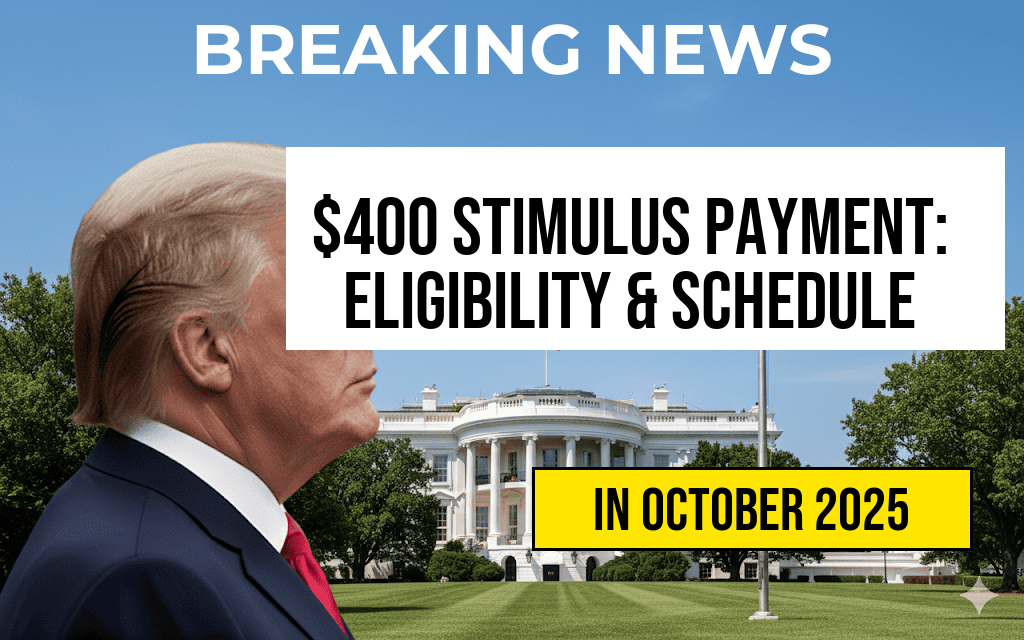A new federal stimulus initiative has announced a $400 stimulus payment for eligible Americans, aimed at providing financial relief amid ongoing economic challenges. The program, designed to reach a broad segment of the population, is structured around specific eligibility criteria and a detailed payment schedule. Recipients can expect to receive their payments through direct deposit or mailed checks, with the process beginning shortly after qualification is confirmed. This initiative reflects ongoing efforts by policymakers to support individuals and families facing inflationary pressures, rising living costs, and unpredictable economic conditions. Below is a comprehensive overview of the eligibility requirements, application process, and complete payment schedule to help Americans understand how they can access these funds and what to expect in the coming months.
Eligibility Requirements for the $400 Stimulus Payment
Income Limits and Filing Status
- Individuals must have an adjusted gross income (AGI) of $75,000 or less for single filers.
- Married couples filing jointly with an AGI of up to $150,000 qualify for the full amount.
- Heads of households with an income of $112,500 or less are eligible.
Residency and Tax Filing Requirements
- Applicants must be U.S. residents or citizens who file a federal tax return for the previous year.
- Individuals who did not file a tax return in the prior year but meet income thresholds may need to file a simplified return or claim via a designated portal.
- Those with a valid Social Security number and who are not claimed as dependents on another taxpayer’s return qualify.
Additional Criteria
- Recipients should not be incarcerated at the time of disbursement.
- Applicants must not have outstanding debts with federal agencies that could offset the payment, such as unpaid student loans or taxes.
- Individuals receiving other forms of government assistance, such as Social Security or unemployment benefits, are generally eligible if they meet income criteria.
Application Process and How to Confirm Eligibility
Most eligible individuals will automatically receive the $400 stimulus payment based on their recent tax filings, similar to previous relief efforts. For those who did not file taxes or need to update their information, the government has set up a dedicated portal to verify eligibility and submit claims. It is advisable to consult official sources, such as the IRS website (irs.gov), for detailed instructions and to avoid potential scams.
Steps to Follow
- Review income and filing status to determine eligibility.
- Register or update information through the official portal if necessary.
- Ensure your bank details are current for direct deposit options.
- Track the status of your payment via the official tracking tools provided by the IRS or the relevant agency.
Complete Payment Schedule and Disbursement Timeline
| Qualification Confirmation Date | Expected Payment Date | Payment Method |
|---|---|---|
| Early March 2024 | Mid-March 2024 | Direct deposit or mailed check |
| Late March 2024 | Early April 2024 | Direct deposit or mailed check |
| April 2024 onwards | Ongoing through May 2024 | Based on processing times and verification |
Factors Affecting Disbursement Timing
- The volume of applications and verifications may slightly delay processing times.
- Payments for those who file late or need manual verification could be scheduled later in the timeline.
- Individuals with updated banking information are likely to receive funds faster via direct deposit.
Additional Resources and Important Notices
For further details, including frequently asked questions and updates on the program, individuals should consult official resources such as the IRS COVID-19 Relief page or the U.S. Department of Treasury website. Be cautious of fraudulent schemes promising early access to payments or requesting personal information outside official channels.
While this stimulus payment aims to provide much-needed assistance, the government emphasizes that eligibility criteria may evolve, and recipients should stay informed through trusted government sources. The program underscores ongoing efforts to bolster economic resilience and support households navigating persistent financial challenges.
Frequently Asked Questions
Who is eligible to receive the $400 stimulus payment?
Eligible recipients must meet specific income thresholds, be residents of the qualifying state or region, and have filed their tax returns for the relevant year. Details on eligibility criteria are provided in the article.
How can I check the status of my stimulus payment?
You can track your payment status through the official government payment portal by entering your personal details and tax information. The article outlines the step-by-step process for tracking your payment.
What is the payment schedule for the stimulus?
The complete payment schedule includes specific dates when the $400 payments will be issued, often based on application date or filing deadline. The article provides a detailed calendar of payment disbursements.
Are there any additional requirements to qualify for the stimulus payment?
Yes, applicants may need to meet residency, income, and filing requirements, and ensure they have submitted all necessary documentation. The article highlights common documentation and eligibility checks.
What should I do if I missed the payment or didn’t receive it?
If you did not receive your $400 stimulus payment, you should verify your eligibility and check your payment status. The article suggests contacting customer support or filing a recovery claim if needed.

Leave a Reply